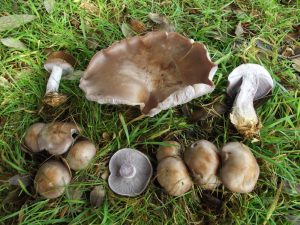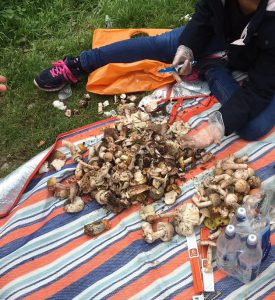19/07/2019
At least once a week during the summer, much more frequently in the autumn, I am contacted by desperate parents worried about their child (or dog) having eaten a wild mushroom. Quite a few of these people have already tried phoning 999 or 111, and got an inappropriate and unhelpful response. I’m not talking about the situation where a child is showing worrying symptoms and the parents think they might have eaten a mushroom. These people know this has happened, and they’ve got a photograph of the offending fungus.
Taking a photograph is exactly the right thing to do, because in the unfortunate case where the mushroom in question in one of the really dangerous ones then responding quickly with the correct medical procedure is crucial to minimising the damage. Unfortunately, the NHS response is the wrong one. I’ve tried googling it myself, and this page illustrates the problem. I’ve also phoned 111. The person I spoke to tried to help, but was only able to quote/follow the same inadequate procedure.
The problem is that the NHS responds by asking questions about symptoms of poisoning instead of attempting to visually identify the fungus from the photo. The worried parents are often making this call immediately after consumption has taken place, but even the most fast-acting mycotoxins take at least thirty minutes to kick in. The most lethal of all can take several hours, even though those toxins are being absorbed into the bloodstream. If you wait until the victim is displaying symptoms of poisoning, or even worse, until there has been positive result in a toxicology test, then damage may already have been done. It may be too late to save them. And yet in many cases, if you can access somebody with the correct knowledge, the fungus can be identified from the photo in seconds. This can either end the emergency (99% of the time it turns out the mushroom is harmless), or confirm that the mushroom is indeed toxic, and provide accurate information about which toxins are involved and what the response needs to be. Immediately.
So what can be done about this?
Doubtless people will continue to contact me, and I will do my best to help them, but I am not an emergency service and I don’t always answer my phone. There is a helpful Facebook group called Poisons Help; Emergency Identification For Mushrooms & Plants, though not everybody uses Facebook or owns a smartphone. There are many other places online where mushrooms are identified, but not reliably. The internet is full of bad information, and sometimes it takes an expert to tell. There are too many people who over-estimate their ability to identify fungi from photos, or confidently misidentify things having failed to even ask where in the world the photo was taken. Mistakes are frequent, including both toxic species misidentified as edible and edible ones falsely condemned as poisonous.
There really does need to be a change to the procedures followed by the staff who man the 111 lines, and anywhere else in the NHS where people are going to receive this sort of enquiry. The rule needs to be this: if a photo has been supplied then your first response, after establishing that there aren’t any immediate symptoms, must be to attempt to accurately identify the species involved. The NHS should have procedures in place so they know how to do this, instead of telling callers to 111 that they have no idea how to help. If your child has eaten a Deathcap, you shouldn’t have to end up having to navigate your own way through the murky and confusing world of internet mycology, and hope that you end up in contact with somebody who is able to help. As things stand, avoidable deaths or permanent and serious organ damage could very easily occur.
Here are four of the most dangerous toxic mushrooms found in the British Isles:











